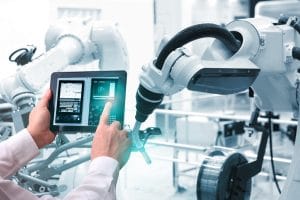 Heat exchangers first made an impact as a more affordable, efficient, and eco-friendly solution for cooling electrical enclosures (such as control cabinets). Before their introduction, companies relied mainly on thermal management solutions such as air conditioners and air compressors, which utilize cold air to prevent electrical waste heat from causing damage. Such solutions were effective when cooling large-scale equipment in the past, but they also came with high energy requirements and frequent, costly repairs and maintenance. For more advanced applications, like automated technology, such cooling solutions weren’t as viable. Yet, with heat exchangers, companies could enjoy faster and more powerful technologies without having to invest a fortune in thermal management for them.
Heat exchangers first made an impact as a more affordable, efficient, and eco-friendly solution for cooling electrical enclosures (such as control cabinets). Before their introduction, companies relied mainly on thermal management solutions such as air conditioners and air compressors, which utilize cold air to prevent electrical waste heat from causing damage. Such solutions were effective when cooling large-scale equipment in the past, but they also came with high energy requirements and frequent, costly repairs and maintenance. For more advanced applications, like automated technology, such cooling solutions weren’t as viable. Yet, with heat exchangers, companies could enjoy faster and more powerful technologies without having to invest a fortune in thermal management for them.
The limitations of previous cooling systems
Traditional electrical cooling solutions operate on the idea of using a supply of chilled air to stop electrical waste heat from causing a system to overheat. The cooling unit generates cold air through HVAC or air compression processes, then circulates the chilled air through the inside of an electrical enclosure. This process can effectively stop overheating, but it also comes with its own burdens, such as a need for high amounts of energy and to repeatedly maintain and repair the complex cooling equipment. By contrast, heat exchangers are designed to stop systems from overheating by absorbing and transferring electrical waste heat before it has a chance to accumulate.
The innovation of advanced thermal management
The good thing about cooling enclosures with heat exchangers is that transferring heat doesn’t require the creation and circulation of chilled air through the enclosure. Instead, they work by using an eco-friendly cooling fluid to rapidly absorb waste heat as soon as electrical components generate it. After absorbing the heat, the fluid can quickly transfer it through the heat exchanger to a cooler area, such as a heat sink, where it can release the heat and flow back to continue transferring more. This creates a more efficient and easily manageable electrical cooling solution that can handle high-performance cooling needs without requiring as much space or energy to operate.
The automated roles of custom heat exchangers
For advancing technologies that require highly reliable, high-performance electrical thermal management solutions, heat exchangers have proven increasingly more important. In the case of automated technology, for example, systems are typically designed to handle high-frequency, repetitive tasks with little or no input from employees. Heat exchangers help make that possible by providing a cooling solution that is not only capable of handling automated tech’s cooling needs, but can also do so without requiring constant maintenance and repairs or high amounts of energy.
For more information about the role of heat exchangers in the rise of automated tech, call Noren Thermal Solutions in Taylor, TX, at 866-936-6736.







